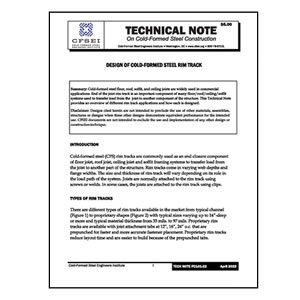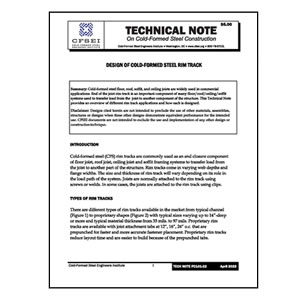Tech Note FC101-22: Design of Cold-Formed Steel Rim Track
$5.00
Summary: Cold-formed steel floor, roof, soffit, and ceiling joists are widely used in commercial applications. End of the joist rim track is an important component of many floor/roof/ceiling/soffit systems used to transfer load from the joist to another component of the structure. This Technical Note provides an overview of different rim track applications and how each is designed.
Disclaimer: Designs cited herein are not intended to preclude the use of other materials, assemblies, structures or designs when these other designs demonstrate equivalent performance for the intended use. CFSEI documents are not intended to exclude the use and implementation of any other design or construction technique.
Related Products

Tech Note B001-20: How Cold-Formed Steel Framing is Produced
Summary: Cold-formed steel seems like a fairly simple product when you are holding it in your hand, but as you can see, there are many production steps involving things like mining iron ore out of the ground, creating molten steel, furnaces above 2,000°F, reduction mills imparting forces in excess of 100,000 pounds per square inch, and hydrochloric acid cleaning baths before it even reaches the roll forming stage. This Tech Note has provided a basic outline of the processes involved in producing the products you work with daily, be it manufacturing, drafting, designing, engineering, installing or demolishing a building at the end of its life cycle.
Disclaimer: Designs cited herein are not intended to preclude the use of other materials, assemblies, structures or designs when these other designs demonstrate equivalent performance for the intended use. CFSEI documents are not intended to exclude the use and implementation of any other design or construction technique.

Tech Note L001-10: Design of Diagonal Strap Bracing Lateral Force Resisting Systems for the 2006 IBC
Summary: This Technical Note is intended to discuss some of the design requirements, detailing and practical limitations of diagonal strap bracing design. Diagonal flat strap bracing is a commonly used type of lateral force resisting system in residential and low rise commercial cold-formed steel applications.
This Technical Note is an editorial revision of Technical Note L001-09.
Disclaimer: Designs cited herein are not intended to preclude the use of other materials, assemblies, structures or designs when these other designs demonstrate equivalent performance for the intended use. CFSEI documents are not intended to exclude the use and implementation of any other design or construction technique.

Tech Note S200-20: Design of Cold-Formed Steel Systems for Raised Platforms, Stages and Theater Seating
Summary: It is common for cold-formed steel (CFS) to be used in the construction of raised platforms, stages, and theater seating. It is the intent of the Technical Note to provide an overview of considerations to address when designing such framing, along with some design examples.
Disclaimer: Designs cited herein are not intended to preclude the use of other materials, assemblies, structures or designs when these other designs demonstrate equivalent performance for the intended use. CFSEI documents are not intended to exclude the use and implementation of any other design or construction technique.

Tech Note B008-20: Basic C-Shaped Wall Stud Behavior
Summary: Although cold-formed steel framing shares some limit states with hot-rolled steel, cold-formed steel framing and specifically C-Shaped studs exhibit unique behaviors when subjected to various loading conditions. This Tech Note gives an overview of those unique behaviors that need to be considered when designing C-Shaped cold-formed steel members.
Disclaimer: Designs cited herein are not intended to preclude the use of other materials, assemblies, structures or designs when these other designs demonstrate equivalent performance for the intended use. CFSEI documents are not intended to exclude the use and implementation of any other design or construction technique.

Tech Note 562-22: Powder-Actuated Fasteners in Cold-Formed Steel Construction
This Technical Note updates and replaces Tech Note 562
Summary: Power-actuated fasteners (PAF’s) are industry standard for attachment of cold-formed steel (CFS) steel framing members, usually track, to concrete, CMU or steel structural elements. “Power-actuated” is the broad category used to refer to fasteners which are driven directly through the CFS and into the substrate, using a powder, gas, compressed air or electro-mechanically driven tool. Efficient installation of framing systems is greatly enhanced by the use of PAF’s. For CFS-to-steel applications, the specification AISI S100 addresses all relevant limit states with equations and safety/ resistance factors. For CFS-to-concrete, limited guidance is provided but not all limit states are covered. This technical note will provide design guidance based on AISI S100, as well as installation and good detailing practice.
Disclaimer: Designs cited herein are not intended to preclude the use of other materials, assemblies, structures or designs when these other designs demonstrate equivalent performance for the intended use. CFSEI documents are not intended to exclude the use and implementation of any other design or construction technique.

Tech Note B003-20: Introduction to Building Codes
Summary: The International Code Council develops a suite of building codes that are considered nationally to be the model codes for the building industry. Local jurisdictions adopt, and in some cases amend, the codes and they become the law of the jurisdiction for building design and construction. The adopted building codes are intended to provide minimum requirements to provide a safe building environment. Among other requirements, the code dictates the maximum allowable size of a building based on its intended use, materials used in construction, fire resistance rating of structural elements, and the presence of automatic sprinkler systems. The International Building Code establishes all design loads to be applied to the building or structure. The building code also relies on references to other standards and specifications to ensure the provisions reflect the current industry practice. For cold-formed steel framing, the IBC references the American Iron and Steel Institute’s suite of framing standards as the accepted design methods and procedures.
Disclaimer: Designs cited herein are not intended to preclude the use of other materials, assemblies, structures or designs when these other designs demonstrate equivalent performance for the intended use. CFSEI documents are not intended to exclude the use and implementation of any other design or construction technique.

Tech Note G105-22: Compression Member Reinforcement
Summary: To modify the capacity of a compression member, e.g. wall stud or truss web, adding a reinforcement may result in a non-prismatic member. This Tech Note provides guidance to evaluate the strength of a non-prismatic compression member.
Disclaimer: Designs cited herein are not intended to preclude the use of other materials, assemblies, structures or designs when these other designs demonstrate equivalent performance for the intended use. CFSEI documents are not intended to exclude the use and implementation of any other design or construction technique.

Tech Note W600-21: Cold-Formed Steel Load-Bearing Wall Design
Summary: This Technical Note has been written to help cold-formed steel (CFS) engineers further their understanding of structural load-bearing CFS walls. Given the myriad of details required for such structures, the importance of proper design and analysis of load-bearing CFS members cannot be understated. This Technical Note will discuss the various design considerations that must be taken into consideration during the design phase of such structures.
Disclaimer: Designs cited herein are not intended to preclude the use of other materials, assemblies, structures or designs when these other designs demonstrate equivalent performance for the intended use. CFSEI documents are not intended to exclude the use and implementation of any other design or construction technique.

